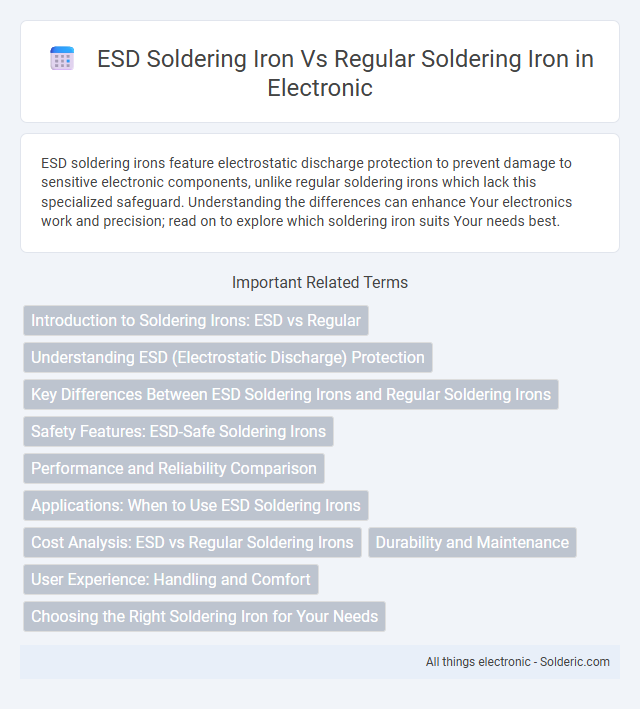ESD soldering irons feature electrostatic discharge protection to prevent damage to sensitive electronic components, unlike regular soldering irons which lack this specialized safeguard. Understanding the differences can enhance Your electronics work and precision; read on to explore which soldering iron suits Your needs best.
Comparison Table
| Feature | ESD Soldering Iron | Regular Soldering Iron |
|---|---|---|
| Purpose | Prevents electrostatic discharge damage | General soldering tasks without ESD protection |
| Static Control | Built-in ESD-safe materials and grounding | No static discharge protection |
| Usage | Ideal for sensitive electronic components | Suitable for standard electronic repairs and hobbies |
| Cost | Higher price due to ESD features | Generally more affordable |
| Tip Temperature Stability | Often better temperature control | Varies by model, may lack precise control |
| Durability | Designed for electronics industry standards | Suitable for general use, less specialized |
Introduction to Soldering Irons: ESD vs Regular
ESD soldering irons are specifically designed to prevent electrostatic discharge, protecting sensitive electronic components during soldering processes. Regular soldering irons lack ESD protection, which can cause damage to delicate semiconductors and circuit boards. Using an ESD soldering iron ensures safer handling of static-sensitive devices in electronics manufacturing and repair.
Understanding ESD (Electrostatic Discharge) Protection
ESD soldering irons are specifically designed to prevent electrostatic discharge, which can damage sensitive electronic components during soldering. These irons feature built-in grounding and static-dissipative materials to safely neutralize static electricity, ensuring your electronic devices remain protected. Regular soldering irons lack this protection, posing a higher risk of component failure due to unnoticed static discharges.
Key Differences Between ESD Soldering Irons and Regular Soldering Irons
ESD soldering irons are designed with built-in electrostatic discharge protection to prevent damage to sensitive electronic components, featuring grounded tips and anti-static materials. Regular soldering irons lack this protection, posing a risk of static damage in electronics assembly. The key difference lies in ESD safe construction and enhanced safety for delicate circuit boards.
Safety Features: ESD-Safe Soldering Irons
ESD-safe soldering irons are designed with conductive materials and grounding features to prevent electrostatic discharge, protecting sensitive electronic components from damage during soldering. These tools often include anti-static handles and wrist straps for enhanced user protection, ensuring a controlled environment that minimizes static build-up. Regular soldering irons lack these safety features, increasing the risk of ESD-related failures in electronic assembly and repair.
Performance and Reliability Comparison
ESD soldering irons feature built-in static dissipative materials that protect sensitive electronic components from electrostatic discharge, ensuring higher reliability in circuit board repairs. These irons maintain consistent temperature control and often include features like anti-static grips, which enhance performance during delicate tasks compared to regular soldering irons. Choosing an ESD soldering iron improves your work's precision and reduces the risk of damage to ESD-sensitive devices, making it the superior option for electronics assembly and repair.
Applications: When to Use ESD Soldering Irons
ESD soldering irons are essential for working with sensitive electronic components in devices like smartphones, computers, and medical instruments to prevent electrostatic discharge damage. Regular soldering irons suit tasks involving durable materials such as plumbing, metalwork, or large-scale electronics where static sensitivity is not a concern. Selecting an ESD soldering iron is crucial in environments handling integrated circuits and semiconductors to ensure component reliability and performance.
Cost Analysis: ESD vs Regular Soldering Irons
ESD soldering irons typically cost 20-40% more than regular soldering irons due to the integrated electrostatic discharge protection components that safeguard sensitive electronics. Regular soldering irons lack this feature, resulting in lower initial purchase prices but increased risk of damage to electrostatic-sensitive devices. Investing in an ESD soldering iron can reduce costly component failures and rework expenses, offsetting the higher upfront cost over time.
Durability and Maintenance
ESD soldering irons are designed with anti-static features that reduce the risk of damage to sensitive electronic components, enhancing their durability compared to regular soldering irons. They often incorporate higher-quality materials and precision temperature control, which minimizes wear on the heating element and extends the tool's lifespan. Your maintenance routine should focus on cleaning the tip and inspecting grounding elements regularly to ensure optimal performance and longevity in ESD soldering irons.
User Experience: Handling and Comfort
An ESD soldering iron features ergonomic designs with anti-static handles that prevent electrostatic discharge, ensuring a safer experience for sensitive electronic components. You'll notice improved grip and reduced hand fatigue during extended use, thanks to balanced weight and cushioned grips. In contrast, regular soldering irons may lack these comfort and safety features, increasing the risk of static damage and discomfort.
Choosing the Right Soldering Iron for Your Needs
ESD soldering irons feature built-in electrostatic discharge protection, making them ideal for working with sensitive electronic components and preventing damage from static electricity. Regular soldering irons lack this specialized protection but are suitable for general electronics repair and hobbyist applications where static sensitivity is not a concern. Selecting the right soldering iron depends on your specific project requirements, particularly the need for static control when handling delicate circuit boards or semiconductor devices.
ESD soldering iron vs regular soldering iron Infographic

 solderic.com
solderic.com